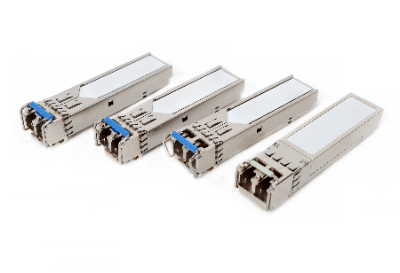What Is an SFP Module?
 SFP (small form-factor pluggable) modules are optical transceivers that convert electrical signals into optical signals.
SFP (small form-factor pluggable) modules are optical transceivers that convert electrical signals into optical signals.
They are mainly used in data communication applications to connect network devices. SFP modules can be used with UTP cables, which have a transmission distance limit of 100 meters, and can be extended beyond this limit.
It is specified by the multi-source agreement (MSA) and supports gigabit ethernet, SONET and other communication standards.
Uses of SFP Modules
SFP modules are used to convert electrical signals into optical signals; with SFP modules, transmission media such as multi- and single-mode fiber, twisted pair cables, and coaxial cables can be connected with the required distance length and transmission speed.
They are also used in “storage interface cards” called HBAs or fibre channel storage switches, and support a wide range of speeds from 2 to 8G. Compact SFP Modules offer a variety of fiber-optic connections.
These low-cost modules are useful for increasing the flexibility of devices, such as switching hubs, routers, and firewalls. SFP Modules that provide fiber-optic connectivity are also characterized by their resistance to noise. Therefore, they are used to prevent communication problems in environments with many noise sources.
Principle of SFP Modules
The following components make up the SFP module:
- CDR (Clock and Data Recovery)
- TIA/LA (Trans-impedance Amplifier/Limiting Amplifier)
- MCU (Microcontroller Unit)
- LDD (Laser Diode Driver)
- TOSA (Transmitter Optical Subassembly)
- ROSA (Receiver Optical Subassembly)
The TOSA converts the electrical signal into an optical signal for transmission, and the ROSA converts the optical signal into an electrical signal for reception. The CDR matches the signal on the receiving side with the signal on the transmitting side. The TIA processes the current signal converted by the ROSA into a voltage signal of a specific amplitude. The LA processes this output amplitude into a voltage signal of equal amplitude.
The LDD converts the clock signal output from the CDR into the corresponding modulation signal, which drives the laser to transmit an optical signal. The MCU is responsible for monitoring the operating status of the optical module and maintaining optical communications. Specifically, the MCU monitors parameters related to software operation, temperature, voltage, current, receiving power, and transmitting power in real time to determine the operating state of the optical module.
Types of SFP Modules
There are two types of SFP: SFP Fiber Module and SFP Copper Module.
1. SFP Fiber Module
Most SFP fiber modules are either CWDM (Coarse Wavelength Division Multiplexing) SFP or DWDM (Dense Wavelength Division Multiplexing) SFP, with CWDM using wide channel spacing and a maximum transmission distance of 120 km and DWDM using high-density channel spacing and a maximum transmission distance of 200 km.
2. SFP Copper Module
There are three types of SFP Copper Modules: 1000BASE-T, 10/100BASE-T, and 10/100/1000BASE-T. The operating distance for 1000BASE-T is 100 m over twisted pair cable; for 10/100BASE-T and 10/100/1000BASE-T, it is 100 m over copper twisted pair cable. It is important to select the SFP Module according to the required operating distance.
Other Information on SFP Modules
Cautions for SFP Modules
When using SFP modules, the most important thing to consider is compatibility.
You must be very sure that the SFP module is compatible with the device to which it will be connected.
The operating environment and maintenance methods are important to prolong the service life. Avoid damaging end-faces, plugging in lightly, and using in proper humidity.